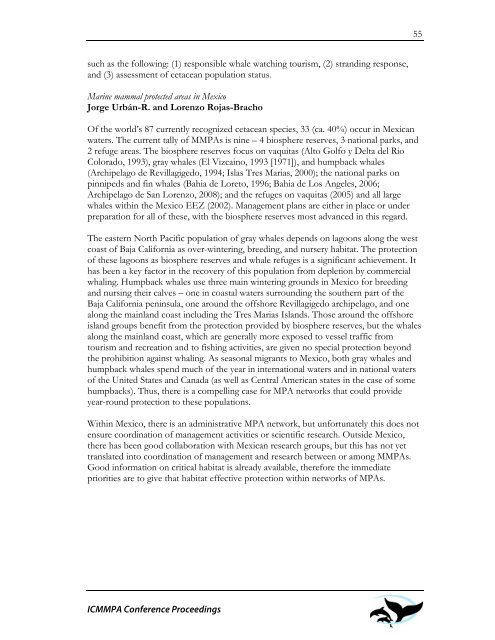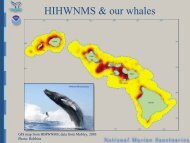The First International Conference on Marine Mammal Protected Areas
The First International Conference on Marine Mammal Protected Areas
The First International Conference on Marine Mammal Protected Areas
Create successful ePaper yourself
Turn your PDF publications into a flip-book with our unique Google optimized e-Paper software.
such as the following: (1) resp<strong>on</strong>sible whale watching tourism, (2) stranding resp<strong>on</strong>se,<br />
and (3) assessment of cetacean populati<strong>on</strong> status.<br />
<strong>Marine</strong> mammal protected areas in Mexico<br />
Jorge Urbán-R. and Lorenzo Rojas-Bracho<br />
Of the world’s 87 currently recognized cetacean species, 33 (ca. 40%) occur in Mexican<br />
waters. <str<strong>on</strong>g>The</str<strong>on</strong>g> current tally of MMPAs is nine – 4 biosphere reserves, 3 nati<strong>on</strong>al parks, and<br />
2 refuge areas. <str<strong>on</strong>g>The</str<strong>on</strong>g> biosphere reserves focus <strong>on</strong> vaquitas (Alto Golfo y Delta del Rio<br />
Colorado, 1993), gray whales (El Vizcaino, 1993 [1971]), and humpback whales<br />
(Archipelago de Revillagigedo, 1994; Islas Tres Marias, 2000); the nati<strong>on</strong>al parks <strong>on</strong><br />
pinnipeds and fin whales (Bahia de Loreto, 1996; Bahia de Los Angeles, 2006;<br />
Archipelago de San Lorenzo, 2008); and the refuges <strong>on</strong> vaquitas (2005) and all large<br />
whales within the Mexico EEZ (2002). Management plans are either in place or under<br />
preparati<strong>on</strong> for all of these, with the biosphere reserves most advanced in this regard.<br />
<str<strong>on</strong>g>The</str<strong>on</strong>g> eastern North Pacific populati<strong>on</strong> of gray whales depends <strong>on</strong> lago<strong>on</strong>s al<strong>on</strong>g the west<br />
coast of Baja California as over-wintering, breeding, and nursery habitat. <str<strong>on</strong>g>The</str<strong>on</strong>g> protecti<strong>on</strong><br />
of these lago<strong>on</strong>s as biosphere reserves and whale refuges is a significant achievement. It<br />
has been a key factor in the recovery of this populati<strong>on</strong> from depleti<strong>on</strong> by commercial<br />
whaling. Humpback whales use three main wintering grounds in Mexico for breeding<br />
and nursing their calves – <strong>on</strong>e in coastal waters surrounding the southern part of the<br />
Baja California peninsula, <strong>on</strong>e around the offshore Revillagigedo archipelago, and <strong>on</strong>e<br />
al<strong>on</strong>g the mainland coast including the Tres Marias Islands. Those around the offshore<br />
island groups benefit from the protecti<strong>on</strong> provided by biosphere reserves, but the whales<br />
al<strong>on</strong>g the mainland coast, which are generally more exposed to vessel traffic from<br />
tourism and recreati<strong>on</strong> and to fishing activities, are given no special protecti<strong>on</strong> bey<strong>on</strong>d<br />
the prohibiti<strong>on</strong> against whaling. As seas<strong>on</strong>al migrants to Mexico, both gray whales and<br />
humpback whales spend much of the year in internati<strong>on</strong>al waters and in nati<strong>on</strong>al waters<br />
of the United States and Canada (as well as Central American states in the case of some<br />
humpbacks). Thus, there is a compelling case for MPA networks that could provide<br />
year-round protecti<strong>on</strong> to these populati<strong>on</strong>s.<br />
Within Mexico, there is an administrative MPA network, but unfortunately this does not<br />
ensure coordinati<strong>on</strong> of management activities or scientific research. Outside Mexico,<br />
there has been good collaborati<strong>on</strong> with Mexican research groups, but this has not yet<br />
translated into coordinati<strong>on</strong> of management and research between or am<strong>on</strong>g MMPAs.<br />
Good informati<strong>on</strong> <strong>on</strong> critical habitat is already available, therefore the immediate<br />
priorities are to give that habitat effective protecti<strong>on</strong> within networks of MPAs.<br />
ICMMPA <str<strong>on</strong>g>C<strong>on</strong>ference</str<strong>on</strong>g> Proceedings<br />
55



